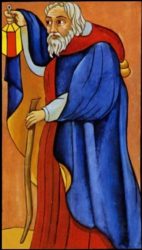Translated from Letter to a Friend, or Political, philosophical, and religious considerations on the French Revolution by Louis Claude de Saint-Martin. (French title: Lettre à un ami ou Considérations politiques, philosophiques et religieuses sur la Révolution française
In a wide ranging discussion of the French Revolution written in the form of a letter to a friend, Louis Claude de Saint-Martin turns, in these passages to the question of demonstrating the existence of God. Moving beyond the philosophical arguments, Saint-Martin is intent on demonstrating the God who is active in the soul and in the world.
The atheist is unable to see that God is reflected in the human soul. In denying that, the atheist is veiling the very thing that brings attention to his existence, replacing it with the darkness of nothingness. Unlike the Gnostics or the Platonists, Saint-Martin does not see the material world as a prison, since it, too, passively reveals the creative power of God.
An important point he makes is that there must be some common essence between God and man as the basis any possible communication. Ultimately, this can only be recognized and cannot be demonstrated to everyone’s satisfaction. The translation follows.
[12] The true atheist, if there is one, and consequently the truly impious man, is the one who, turning his gaze on the human soul, is unaware of its grandeur and disputes its spiritual immortality, since it is only in the character and the immensity of the gifts and virtues, of which the soul of man is susceptible, that we can see reflected, as in a mirror, all the pure and sacred rays, of which the tableau of God must be composed: thus, to extinguish the human soul is to cover the Divinity with a lugubrious veil that this soul alone has the power to bring to attention in all worlds; it is to extinguish that eternal sun whence everything originates, and to immerse it, with the universality of things, in the mourning and the obscurity of nothingness.
[13] The only means that we would therefore have of proving the true God, the God ruling over free beings, finally the loving God and source of a joy that can be communicated to other beings, would be without doubt to demonstrate in his creature the existence of some base or some essence similar to his, and even to obtain and to feel this joy of which He is the principle; finally, it would be to demonstrate the spiritual and immortal existence of the human soul which, in its radical and integral nature, is fully desire and fully love, finding itself to be then the active witness of the holy and loving God, as physical nature is the passive witness of the powerful and creator God, we would have placed thereby all the foundations of the building, and it would only be a question of working on its construction: for it is very much without doubt that the immortal existence of the human soul has been recognized, as several good spirits have done on earth; but to recognize a thing, is not always to demonstrate it.

3 Replies to “The Tableau of God”
Comments are closed.